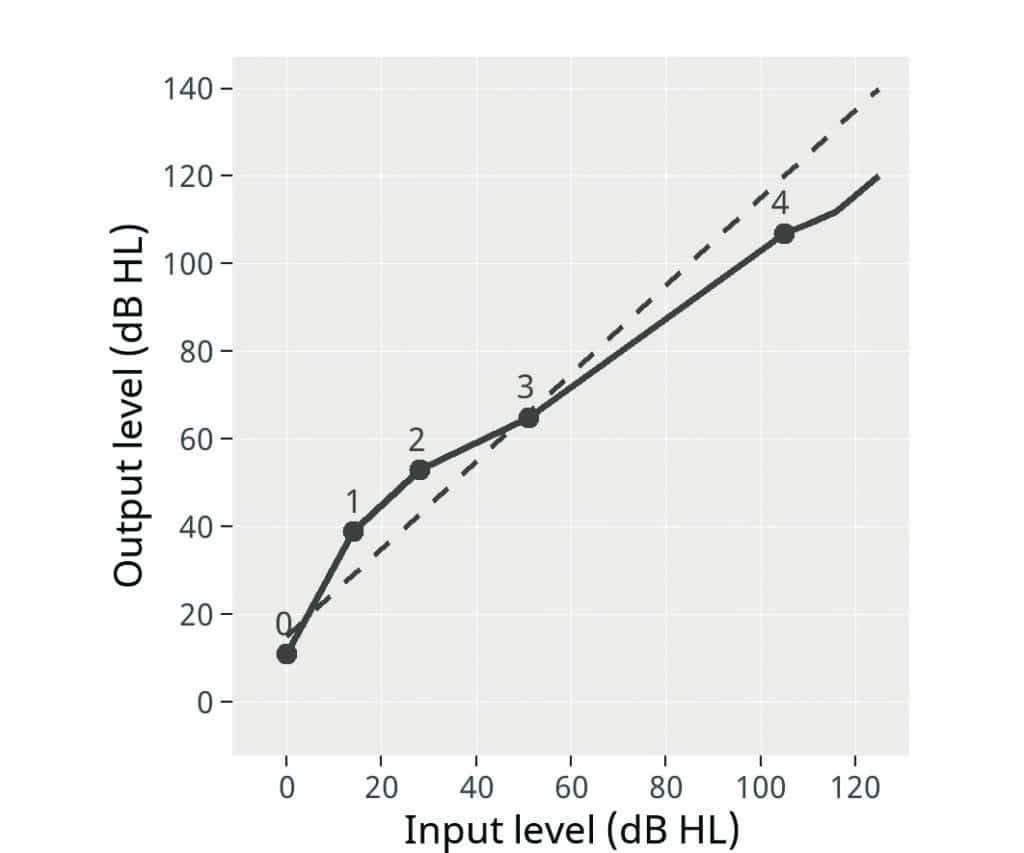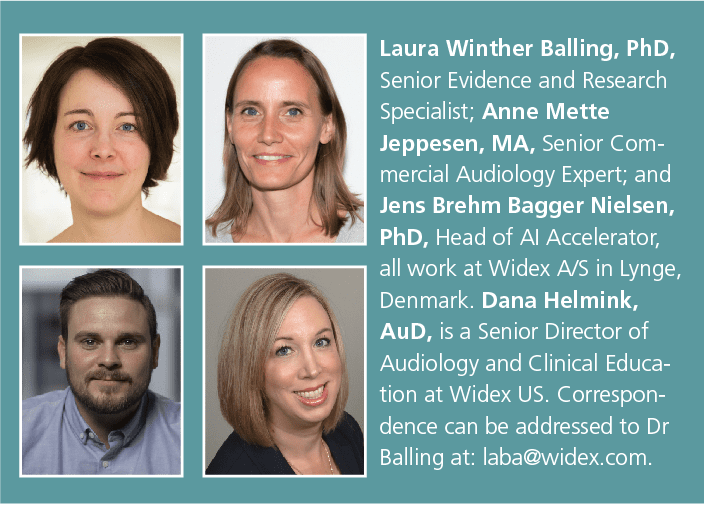Tech Topic | November 2022 Hearing Review
Widex MySound is an AI-based function that allows the user to personalize their sound
By Laura Winther Balling, Anne Mette Jeppesen, Jens Brehm Bagger Nielsen, and Dana Helmink
There is a strong case for personalization of compression for the individual hearing aid user, with research indicating large variation between individuals and situations in preferences and performance. Such personalization has, until now, been limited to complicated adjustments of gain and compression in the fitting software. In contrast, the new Widex MySound enables the user to personalize compression in a completely new way.
Compression in hearing aids addresses the fundamental problem that people with hearing loss have a reduced dynamic range compared to those with normal hearing. Therefore, compression – or, more broadly speaking, non-linear amplification – is a central part of current hearing aids, although the way in which it is implemented varies. Moreover, there is strong evidence that listeners vary in which type of compression is most beneficial for them, making the case for compression to be personalized.
Based on a brief outline of the key parameters of compression, this article summarizes the research on variation in preference and performance with different compression speeds. This research is the foundation for including compression speed in the AI-based Widex MySound personalization, a tool for empowering hearing aid users to control their sound in daily life.
Key Parameters of Non-linear Amplification
While linear amplification applies the same amount of gain to all input levels, non-linear amplification varies with input level (Figure1). Compression is when the increase in output level is smaller than the increase in input level (eg, between points 2 and 3 in Figure 1), while expansion is when the output level increases more than the input level does (eg, between points 0 and 1 in Figure 1). Compression ratios – the change in input level that produces a 1 dB change in output level – vary between different hearing aid brands and fitting rationales, as do the points at which the ratios change, the so-called knee points.

Another key parameter is compression speed, the speed at which the gain changes in response to changes in input level. Such input level changes may be sudden large changes, such as an engine suddenly stopping or applause after a speech, or small fluctuations, such as the modulations and silent pauses of speech.
Compression speed is determined by attack time and release time. The time within which the compressor reacts to an increase in input level by reducing gain is known as attack time. This is crucial for protecting listeners against too loud input, which means that attack times are commonly fast, around 5 ms.1 Research on compression speed therefore centers mostly on release times, ie, how quickly gain is increased when the input level decreases.
Pros and Cons of Fast and Slow Compression
Both fast and slow compression come with advantages and disadvantages, which also depend on compression ratios and knee points. The full system is complex, with many interdependencies, and the research on the effects of different choices is not always clear-cut. Nevertheless, some broad trends emerge and are discussed in the following.
The primary advantage of fast compression is that it quickly adapts to the input level and, thus, more quickly represents changes in the listening environment. This, for instance, makes soft sounds following loud sounds more audible. It also allows softer speech sounds, typically unvoiced consonants, to be amplified relatively more than louder speech sounds, typically vowels.
However, these advantages of fast compression come at the cost of altering the temporal envelope, which is problematic in several ways. Conversely, preserving the temporal envelope is a major advantage for slow compression. This is illustrated in (Figure 2), which shows how the peaks and valleys of the signal are better preserved with the slower release time in the upper waveform. In the lower waveform, the faster compression reduces the intensity differences, resulting in the background noise getting amplified during pauses in the speech.

This preservation of the temporal envelope with slow compression allows higher naturalness and better sound quality3-6 as well as increased listening comfort.7 In addition, slow compression better preserves interaural level differences, which are crucial for sound localization.8 And for hearing aid wearers with poor working memory6,8,9 and more severe hearing losses,10,11 the preservation of the temporal envelope of speech using slow compression seems particularly beneficial.
Because of these benefits, the Widex Variable Speed Compressor predominantly uses slow compression, but faster changes are used in certain circumstances to make sure that soft sounds following loud sounds do not become inaudible. With the dominance of the slow compressor, sound quality is prioritized, while the addition of a fast element increases the audibility of soft sounds and the intelligibility of speech in relevant situations.8,12
Personalization of Compression
Although there is a strong case for a variable speed compression system, it remains a fact that “some patients prefer and/or perform better with fast compression whereas others prefer and/or perform better with slow compression.”1 The studies cited above indicate considerable individual variation in listeners’ compression speed preferences. Souza et al13 argue that differences in performance are likely to arise from large individual variation between listeners.
In addition to differences between individuals, preference and performance are also likely to vary between different noise types14 and between different speech materials.15 In short, preference and performance with different compression speeds vary between both individuals and situations, making it an ideal parameter to personalize for the specific hearing aid wearer in the specific situation.
This is done in the updated Widex MySound in the Widex Moment app. MySound is an AI-based function that allows the user to personalize their sound if they find that they would like to tailor the sound beyond what the automatic processing of the hearing aid provides.
The original MySound manipulated gain in three frequency bands with positive effects on sound quality16-18 and listening comfort.17 In addition to gain in three frequency bands, the updated AI engine now allows the user to manipulate how the fast compressor works around the working point of the slow compressor.
The way these manipulations translate into sound experience may be illustrated through a situation with a mixture of loud sounds coming from a source relatively close to the listener and soft sounds coming from further away. With expansion, the angle of the input-output curve is steeper(Figure 1), giving relatively more emphasis to the louder sounds. With compression, the angle is less steep (Figure 1), giving relatively more amplification to the softer sounds. This means that a more compressed sound may make it easier to hear sounds coming from a distance, giving an impression of acoustically opening up the environment. Conversely, more expansion emphasizes louder sounds in the environment and can therefore allow emphasis on nearer sounds (which tend to be louder) and reduce interference from more distant sounds, including noise in noisy situations.
Importantly, as with previous generations of MySound, the user does not manipulate the signal processing settings directly. Instead, the user simply indicates how much they prefer different settings in a series of A-B comparisons, which is a relatively simple task, but provides sufficient information for a powerful AI engine to create personalized settings.
Perspectives
In short, there is a strong case for personalization of compression for the individual hearing aid user. This has until now been limited to adjusting gain and compression in the fitting software – a cumbersome process of translating sound experiences to compression settings in a situation far from the environment where changes are relevant. In contrast, the new MySound enables the user to personalize compression in a completely new way.
More generally, it remains a central tenet of the way Widex designs hearing solutions that a great individualized fit in the clinic may be followed up with in-the-moment personalization by motivated users, who feel empowered by their ability to control their sound. Crucially, this personalization relies on an industry-leading combination of sophisticated AI, data from a large community of users, and personal input from the specific person in the specific situation. Adding compression to the list of parameters that can be personalized takes this approach an important step further.

Citation for this article: Balling LW, Jeppesen AM, Nielsen JBB, Helmink D. Empowering patients with personalized compression. Hearing Review. 2022;29(11):16-18.
References
- Dillon H. Hearing Aids. 2nd ed. Thieme Publishing; 2012.
- Bisgaard N, Vlaming MSMG, Dahlquist M. Standard Audiograms for the IEC 60118-15 Measurement Procedure. Trends Amplif. 2010;14(2):113-120.
- Boike KT, Souza PE. Effect of compression ratio on speech recognition and speech-quality ratings With wide dynamic range compression amplification. Journal of Speech Language and Hearing Research. 2000;43(2):456–468.
- Hansen M. Effects of multi-channel compression time constants on subjectively perceived sound quality and speech intelligibility. Ear and Hearing. 2002;23(4):369–380.
- Neuman AC, Bakke MH, Mackersie C, Hellman S, Levitt H. Effect of release time in compression hearing aids: Paired‐comparison judgments of quality. The Journal of the Acoustical Society of America. 1995;98(6):3182–3187.
- Souza PE, Arehart KH, Shen J, Anderson M, Kates JM. Working memory and intelligibility of hearing-aid processed speech. Frontiers in Psychology. 2015;6(256).
- Moore BCJ. The choice of compression speed in hearing aids: Theoretical and practical considerations and the role of individual differences. Trends in Amplification. 2008;12(2):103-112.
- Kuk F, Hau O. Compression speed and cognition: A variable speed compressor for all. Hearing Review. 2017;24(3):40–48.
- Cox RM, Xu J. Short and long compression release times: Speech understanding, real-world preferences, and association with cognitive ability. Journal of the American Academy of Audiology. 2010;21(2):121-138.
- Souza PE, Jenstad LM, Folino R. Using multichannel wide-dynamic range compression in severely hearing-impaired listeners: effects on speech recognition and quality. Ear and Hearing. 2005;26(2):120-131.
- Davies-Venn E, Souza P, Brennan M, Stecker CG. Effects of audibility and multichannel wide dynamic range compression on consonant recognition for listeners with severe hearing loss. Ear & Hearing. 2009;30(5):494-504.
- Kuk F, Slugocki C, Korhonen P, Seper E, Hau O. Evaluation of the efficacy of a dual variable speed compressor over a single fixed speed compressor. Journal of the American Academy of Audiology. 2019;30:590-606.
- Souza P, Arehart K, Neher T. Working memory and hearing aid processing: Literature findings, future directions, and clinical applications. Frontiers in Psychology. 2015;6(1894):1-12.
- Lunner T, Sundewall-Thorén E. Interactions between cognition, compression, and listening conditions: Effects on speech-in-noise performance in a two-channel hearing aid. Journal of the American Academy of Audiology. 2007;18(7):604-617. https://doi.org/10.3766/jaaa.18.7.7
- Foo C, Rudner M, Ronnberg J, Lunner T. Recognition of speech in noise with new hearing instrument compression release settings requires explicit cognitive storage and processing capacity. Journal of the American Academy of Audiology. 2007;18(7): 618–631.
- Jensen, NS, Hau O, Nielsen JBB, Nielsen TB, Legarth SV. Perceptual effects of adjusting hearing-aid gain by means of a machine-learning approach based on individual user preference. Trends in Hearing. 2019;23.
- Townend O, Nielsen JBB, Balslev D. SoundSense Learn—Listening intention and machine learning. Hearing Review. 2018; 25(6):28–31.
- Jensen NS, Townend O. Machine learning in Widex EVOKE: Perceptual benefits of SoundSense Learn. WidexPress. 2019;42.




